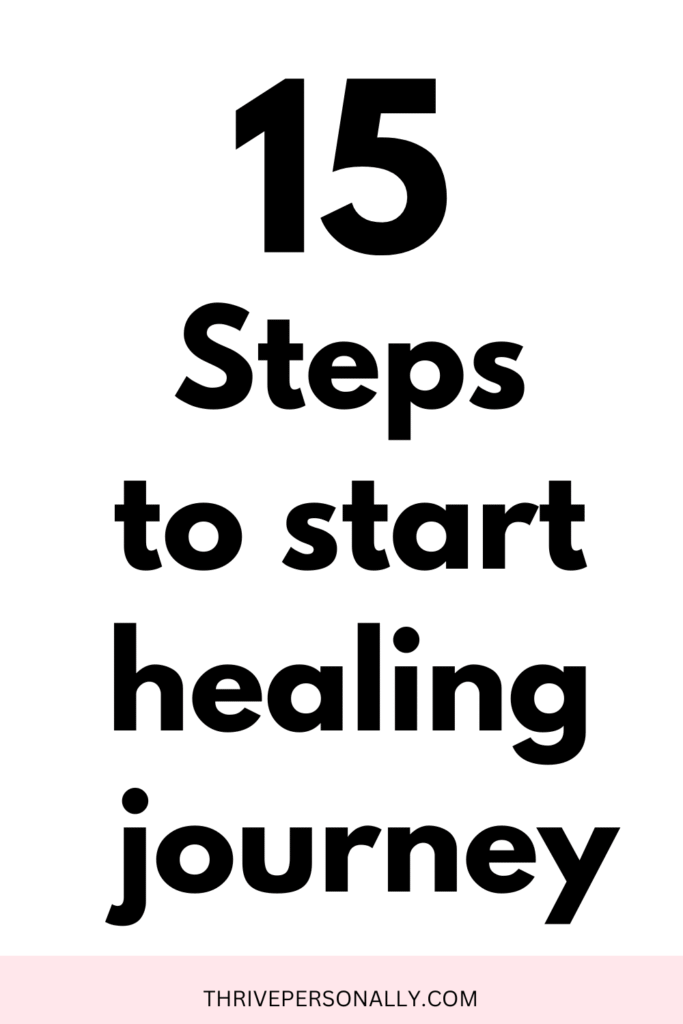Life becomes heavy to bear at some point. Something must have gone wrong—maybe the death of a loved one, years of quiet pain from people or words, or a sorrow you carry without speaking of it. Sometimes you feel empty, confused, or lost. One day, you finally realize things cannot stay the same. That moment is where healing begins.
Healing doesn’t happen overnight. It’s not an easy path, but it is possible. It’s not about going back to who you were—it’s about becoming someone new. A healing journey is the move from injury to growth. It’s a quiet transformation into someone stronger, kinder, wiser, and more at peace. It takes courage, time, and the willingness to face what’s inside. By the end, you won’t be the same—and that’s the point.
These 15 steps can guide you as you begin this journey.
1. Acknowledge That You Need Healing
The first step is admitting that you’re hurting. Maybe you’ve been hiding your pain or pretending you’re fine. But healing begins the moment you say, “I’m hurting. I want to feel better.” That honesty is powerful. It marks the beginning of true change.
You don’t need to share it with everyone—just be real with yourself. That’s enough to reclaim your power and begin.
Read also: 10 Alternatives to Talk Therapy You Should Consider
2. Don’t Hide Your Feelings
Many people avoid emotions like sadness, fear, or anger. But you can’t escape pain—you have to go through it to get past it. Cry when you need to. Be silent when that feels right. Emotions are not your enemy—they are messages from within.
Feeling deeply isn’t weakness. It’s where inner strength begins. Stop running from your feelings, and they’ll stop controlling you.
Read also: 12 Reasons Why You Feel Tired All the Time and How to Fix It
3. Figure Out What Broke You
To heal, you need to know where the pain comes from. It might be one big event or years of quiet wounds. Take time to look back. It might feel uncomfortable, but understanding your story helps you move forward.
When you see the root of the pain, you stop blaming yourself. You begin to recognize what needs healing. Ask yourself gently, “Where did this ache begin?” The answers will help shape your path.
Read also: 15 Signs You Need a Mental Break
4. Talk About Your Suffering
Talking about your pain can ease it. You don’t have to share it with everyone. Even telling a friend, therapist, or writing in a journal helps. Pain feels heavier when it stays locked inside.
Naming your pain makes it something you can face. It also reminds you—you’re not alone. As the American Psychological Association explains, talking about painful emotions helps reduce stress and gives you more control over your healing.
5. Forgive Yourself for the Past
You might blame yourself for what happened—or how you handled it. But punishing yourself won’t help. You did your best with what you knew at the time. Be gentle with yourself. You don’t need to be perfect to be worthy of healing.
Forgiving yourself is a form of self-respect. It says, “I made mistakes, but I still deserve peace.” That mindset is at the heart of healing.
Read also: 50 Ways to Let Go of the Past and Start Fresh
6. Forgive Others—Even If They Don’t Apologize
Some of your pain may come from others. Maybe they hurt you and never said sorry. Forgiveness doesn’t mean what they did was okay. It means you’re choosing not to let their actions keep hurting you.
You forgive for your own peace—not for them. You forgive so you can breathe again. You don’t do it because they deserve it—but because you do. As Mayo Clinic explains, forgiveness supports emotional and mental health.
7. Create a Safe Space for Yourself
Healing needs safety. This might be a quiet room, a walk in nature, or a cozy spot in your home. You need a place free from noise, drama, and people who make you feel worse.
Protect your environment. Say no when needed. Give yourself permission to walk away from anything harmful. Your space matters more than you think.
8. Take Care of Your Body
Your mind and body are connected. When your body is drained, healing becomes harder. Help your body with rest, water, nourishing food, and gentle movement.
Even light activity like stretching or walking can lift your mood. You’re not doing this to look a certain way—just to support healing inside and out.
9. Create a Daily Healing Practice
Having a routine gives structure to your healing. It makes you feel more stable and grounded. This could be meditation, quiet time, journaling, reading, or prayer.
Keep it simple. What matters is that it helps you feel calm and connected to your healing journey.
10. Let Go of What Holds You Back
Some things slow down your healing—certain people, habits, or places that trigger pain. If something makes you feel worse every time, let it go.
Healing needs strong boundaries. That’s not rude or selfish—it’s protecting the part of you that’s trying to grow.
11. Read and Learn About Healing
Knowledge brings strength. When you learn about trauma, emotions, and growth, you learn more about yourself. Books and articles on healing show you that you’re not alone. They also give you tools to help yourself feel better.
According to the National Institute of Mental Health (NIMH), research-backed methods can help people work through emotional pain. The more you understand your struggle, the better equipped you are to face it.
12. Celebrate Small Wins
Healing doesn’t always come with big moments. Most of the time, it’s quiet and slow. One day you might wake up earlier. Another day you might laugh again. These little steps matter. They show that change is happening.
Celebrate these wins. They remind your mind that you’re moving forward. That makes it easier to keep going, even on the tough days.
13. Don’t Rush the Process
Healing doesn’t follow a straight path. Some days you’ll feel better. Other days, pain will return. That’s okay. It’s part of how it works. Be patient with yourself. Don’t expect to be fine overnight.
Showing up for yourself every day is a form of strength. You’re working at it. It might be slow, but you’re moving forward.
14. Let Hope Back Into Your Heart
Pain can close your heart. You might stop trusting, stop dreaming, stop loving. But healing includes letting hope in again. You don’t need to rush—but give yourself permission to believe in life again.
Hope reminds you that life isn’t over. There’s still beauty. You can still find peace. And hope will help carry you through.
15. Remember That You’re Worth Healing
You might believe healing is for others—not for you. You might think you’re too broken or have made too many mistakes. But none of that is true. You deserve to heal. You deserve to feel whole, safe, and strong again.
It’s your life. It’s your story. And you have the power to rewrite the ending. No matter what’s happened, there’s always a place to start again. Every step forward brings you closer to who you’re meant to be.
Final Thoughts
Healing doesn’t erase your pain. It helps you learn to live with it in a way that doesn’t break you. It’s about facing the dark and choosing to bring in light. It’s not returning to who you were—it’s about becoming someone deeper, softer, and stronger.
You may not feel ready. You might not know how to start. But just reading this means you’ve already begun. You are not alone. No matter how hurt you feel, you are not beyond healing.
Healing is real. It’s possible. And it starts with one small step.
Take that step today. Your future is in your hands.
Save the pin for later



